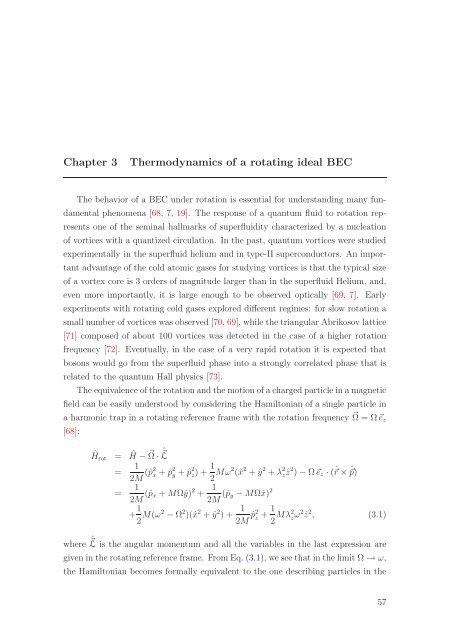PhD thesis in English
PhD thesis in English
PhD thesis in English
Create successful ePaper yourself
Turn your PDF publications into a flip-book with our unique Google optimized e-Paper software.
Chapter 3Thermodynamics of a rotat<strong>in</strong>g ideal BECThe behavior of a BEC under rotation is essential for understand<strong>in</strong>g many fundamentalphenomena [68, 7, 19]. The response of a quantum fluid to rotation representsone of the sem<strong>in</strong>al hallmarks of superfluidity characterized by a nucleationof vortices with a quantized circulation. In the past, quantum vortices were studiedexperimentally <strong>in</strong> the superfluid helium and <strong>in</strong> type-II superconductors. An importantadvantage of the cold atomic gases for study<strong>in</strong>g vortices is that the typical sizeof a vortex core is 3 orders of magnitude larger than <strong>in</strong> the superfluid Helium, and,even more importantly, it is large enough to be observed optically [69, 7]. Earlyexperiments with rotat<strong>in</strong>g cold gases explored different regimes: for slow rotation asmall number of vortices was observed [70, 69], while the triangular Abrikosov lattice[71] composed of about 100 vortices was detected <strong>in</strong> the case of a higher rotationfrequency [72]. Eventually, <strong>in</strong> the case of a very rapid rotation it is expected thatbosons would go from the superfluid phase <strong>in</strong>to a strongly correlated phase that isrelated to the quantum Hall physics [73].The equivalence of the rotation and the motion of a charged particle <strong>in</strong> a magneticfield can be easily understood by consider<strong>in</strong>g the Hamiltonian of a s<strong>in</strong>gle particle <strong>in</strong>a harmonic trap <strong>in</strong> a rotat<strong>in</strong>g reference frame with the rotation frequency ⃗ Ω = Ω⃗e z[68]:Ĥ rot = Ĥ − Ω ⃗ · ˆ⃗ L= 12M (ˆp2 x + ˆp2 y + ˆp2 z ) + 1 2 Mω2 (ˆx 2 + ŷ 2 + λ 2 zẑ2 ) − Ω⃗e z · (ˆ⃗r × ˆ⃗p)= 12M (ˆp x + MΩŷ) 2 + 12M (ˆp y − MΩˆx) 2+ 1 2 M(ω2 − Ω 2 )(ˆx 2 + ŷ 2 ) + 12M ˆp2 z + 1 2 Mλ2 z ω2 ẑ 2 , (3.1)where ˆ⃗ L is the angular momentum and all the variables <strong>in</strong> the last expression aregiven <strong>in</strong> the rotat<strong>in</strong>g reference frame. From Eq. (3.1), we see that <strong>in</strong> the limit Ω → ω,the Hamiltonian becomes formally equivalent to the one describ<strong>in</strong>g particles <strong>in</strong> the57
















